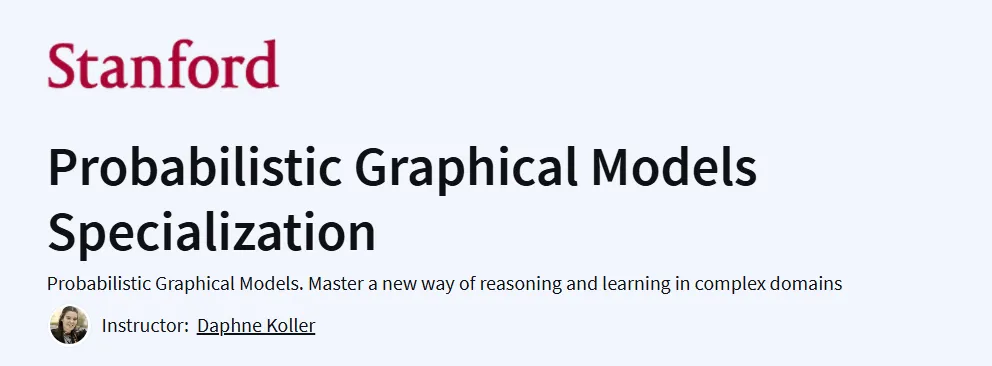What you will learn in Probabilistic Graphical Models Specialization By Stanford University Course
Understand the foundational concepts of probabilistic graphical models (PGMs), including Bayesian networks and Markov networks.
Perform exact and approximate inference in PGMs using algorithms like variable elimination, belief propagation, and Markov Chain Monte Carlo (MCMC) methods.
Learn parameter estimation and structure learning for both directed and undirected graphical models.
Apply PGMs to real-world problems in areas such as medical diagnosis, image understanding, and natural language processing.
Program Overview
Probabilistic Graphical Models 1: Representation
⏱️ 66 hours
Explore the two basic PGM representations: Bayesian Networks (directed graphs) and Markov Networks (undirected graphs).
Understand the theoretical properties and practical uses of these representations.
Engage in hands-on assignments to represent real-world problems.
Probabilistic Graphical Models 2: Inference
⏱️ 38 hours
- Learn how PGMs can be used to answer probabilistic queries.
- Study both exact and approximate inference algorithms, including variable elimination and belief propagation.
- Implement key routines of inference algorithms in programming assignments.
Probabilistic Graphical Models 3: Learning
⏱️ 66 hours
- Delve into learning PGMs from data, focusing on parameter estimation and structure learning.
- Understand the Expectation-Maximization (EM) algorithm and its applications.
- Apply learning algorithms to real-world datasets in programming assignments.
Get certificate
Job Outlook
- Proficiency in PGMs is valuable for roles such as Machine Learning Engineer, Data Scientist, and AI Researcher.
- Skills acquired in this specialization are applicable across various industries, including healthcare, finance, and technology.
- Completing this specialization can enhance your qualifications for positions that require expertise in probabilistic modeling and machine learning.
Specification: Probabilistic Graphical Models Specialization By Stanford University
|
FAQs
- Learn the foundations of Bayesian networks and Markov models.
- Understand how to represent uncertainty in data.
- Explore inference, learning, and decision-making in graphical models.
- Apply concepts to real-world AI and machine learning problems.
- Requires knowledge of probability and linear algebra.
- Familiarity with statistics and machine learning is recommended.
- Some coding experience in Python or similar is helpful.
- Best suited for intermediate to advanced learners.
- Build and interpret Bayesian networks and Markov random fields.
- Perform exact and approximate inference techniques.
- Learn parameter estimation and structure learning.
- Apply models to domains like healthcare, NLP, and vision.
- Strengthen understanding of uncertainty in AI systems.
- Model disease prediction using medical data.
- Apply inference to natural language datasets.
- Use probabilistic models in computer vision tasks.
- Solve structured prediction problems with uncertainty.
- Graduate students in computer science, AI, or statistics.
- Data scientists wanting to master advanced modeling.
- Researchers in fields involving uncertainty and prediction.
- Machine learning engineers building probabilistic systems.





